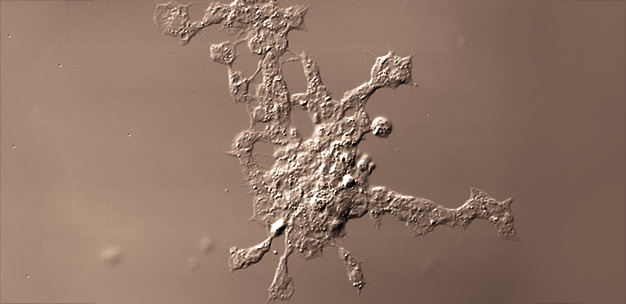Keio researchers reveal a regulatory pathway for RNA molecules that silence genes in reproductive cells
Published online 6 March 2015

Ovarian somatic cells developed at Keio University are used globally to study epigenetic mechanisms in reproductive cells.
© 2015 Haruhiko Siomi, Keio University
In the reproductive cells of all animals, small RNA molecules known as Piwi-interacting RNA (piRNA) play a key role in the epigenetic control of gene expression. Until recently, however, researchers had only a vague idea of how these molecules are produced and regulated.
In 2009, Haruhiko Siomi from Keio University's School of Medicine and his laboratory helped clear up this picture with a publication in Nature that revealed a regulatory circuit that gives rise to both piRNAs and the Piwi proteins they interact with1.
Understanding the biogenesis of piRNA is important because these molecules and their associated proteins play such a significant role in reproduction, explains Siomi. Recent studies have shown that they silence DNA sequences known as transposable elements, which can jump from one location to another in the genome. Left to their own devices, these transposable elements can wreak havoc in the genome, potentially leading to chromosome breakage and major mutations that jeopardize the survival and reproductive capacity of germ cells.
"Many men and women have infertility problems of unknown cause," says Siomi. "Maybe these problems are due to errors or even mutations in the piRNA pathway."
The Keio publication began with "a matter of serendipity," explains Siomi. One day, a researcher in his lab noticed that a small subpopulation of the notoriously fragile cell line used to generate Drosophila germline stem cells was spreading vigorously across the dish. He isolated and carefully nurtured the colony, which continued to grow at an even faster pace, and eventually developed a stable population of ovarian somatic cells (see image).
This stable cell line saved researchers from having to meticulously dissect hundreds of flies under a microscope to collect enough ovaries and testes for a decent experiment. "My students used to hate the job," recalls Siomi. Researchers as far flung as the United States and Europe have shared in the relief, using the cells to study the silencing mechanism of piRNAs.
Using this new cell line, Siomi's team was able to show that piRNA stifles the expression of not only transposable elements, but also protein-coding genes. His team established that this new class of piRNA, named 'genic piRNA', derives from a region of certain protein-coding messenger RNAs that is typically not translated. On closer investigation, a gene appropriately named traffic jam was found to be closely involved with piRNA's fate. Traffic jam plays the dual function of producing genic piRNA and triggering production of Piwi, one of the proteins that piRNA binds with to suppress transposable elements.
The 2009 paper led to more questions, which Siomi's team has since been answering with in vitro experiments. They identified several proteins that interact with the Piwi-piRNA complex to silence transposable elements. And most recently, in research that is yet to be published, they determined the sequence within traffic jam messenger RNA that directs genic piRNA production. The implications of this latest finding are enormous, explains Siomi.
"We can now express piRNAs with sequences of interest to target and silence almost any gene without changing the actual gene sequence." What's more, such an artificial system could be applied across the species divide, from egg-laying flies to fast-breeding mice, and even larger primates.
Reference
- Saito, K. et al. A regulatory circuit for piwi by the large Maf gene traffic jam in Drosophila. Nature 461, 1296-1299 (2009). | article